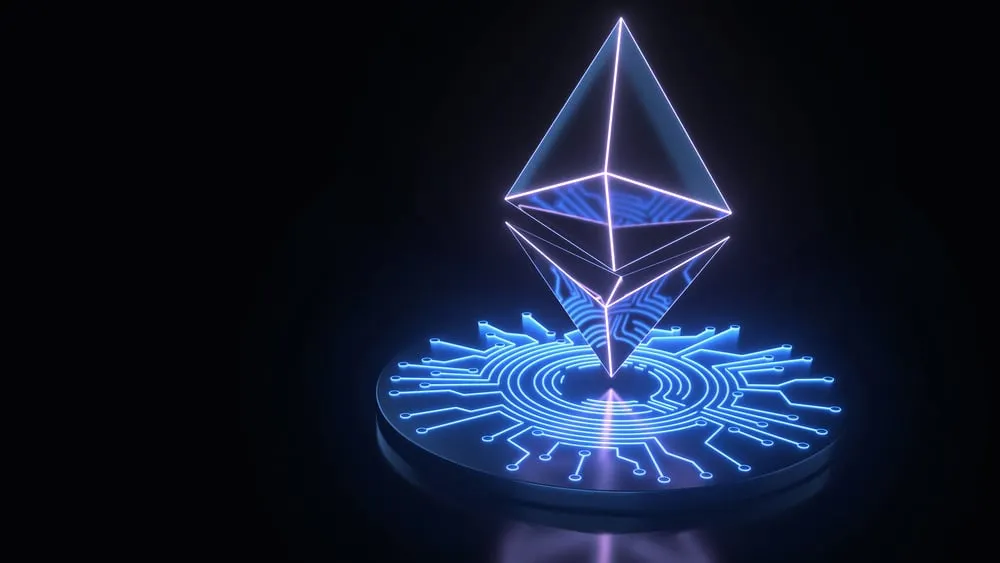📣 Ropsten Merge Announcement 📣
Ethereum's longest lived PoW testnet is moving to Proof of Stake! A new beacon chain has been launched today, and The Merge is expected around June 8th on the network.
Node Operators: this is the first dress rehearsal💃https://t.co/0fDHObLOmn
— Tim Beiko | timbeiko.eth 🐼 (@TimBeiko) May 30, 2022
Coin Prices
BTC
$86,764.00
-0.81%ETH
$2,923.99
-0.99%BNB
$836.13
-1.42%XRP
$1.86
-1.36%USDC
$0.999953
0.02%SOL
$121.46
-2.16%TRX
$0.282812
-0.35%STETH
$2,925.21
-1.16%DOGE
$0.127346
-2.16%FIGR_HELOC
$1.035
-0.05%ADA
$0.355966
-2.19%WBT
$56.43
-1.01%BCH
$570.65
-2.46%WSTETH
$3,576.77
-1.09%WBTC
$86,785.00
-0.43%WBETH
$3,179.05
-1.11%USDS
$0.999873
0.02%WEETH
$3,172.22
-1.13%BSC-USD
$0.99891
-0.05%LINK
$12.18
-1.04%XMR
$431.11
-1.11%LEO
$8.07
-0.19%WETH
$2,926.66
-1.09%XLM
$0.213916
-0.52%ZEC
$408.33
-2.16%USDE
$0.998625
0.04%CBBTC
$86,859.00
-0.71%LTC
$75.61
-1.06%HYPE
$23.82
-0.74%SUI
$1.40
-1.91%AVAX
$12.02
-1.42%HBAR
$0.10875
-1.73%SUSDS
$1.08
0.54%USDT0
$0.9991
-0.03%SHIB
$0.00000704
-1.33%PYUSD
$0.999908
0.07%CRO
$0.093798
-1.12%TON
$1.45
-0.26%WLFI
$0.130876
-1.09%UNI
$5.65
-5.94%SUSDE
$1.21
0.04%MNT
$1.03
-4.20%CC
$0.090054
5.98%USD1
$1.001
0.26%DOT
$1.73
-1.92%RAIN
$0.00797152
2.89%BGB
$3.47
0.91%XAUT
$4,496.65
0.04%M
$1.36
-1.68%OKB
$107.14
-1.17%AAVE
$147.39
-3.08%USDF
$0.998335
0.05%TAO
$207.29
-5.26%NEAR
$1.45
-2.20%ETC
$11.85
-2.01%WETH
$2,927.25
-0.90%HASH
$0.03347469
4.67%BUIDL
$1.00
0.00%JITOSOL
$152.05
-2.04%PI
$0.204263
1.26%PEPE
$0.00000389
-1.89%ICP
$2.95
-1.33%PAXG
$4,501.68
-0.06%ASTER
$0.666387
-3.52%SYRUPUSDC
$1.14
-0.02%USYC
$1.11
0.02%HTX
$0.00000165
-0.27%SOL
$121.62
-2.08%USDG
$0.999518
-0.00%ENA
$0.196551
-1.83%SKY
$0.065788
3.37%JLP
$4.45
-1.09%KCS
$10.77
0.17%RLUSD
$1.00
0.04%BFUSD
$0.998801
0.00%USDC
$0.999733
0.01%NIGHT
$0.075268
-11.03%WLD
$0.482744
-2.71%RETH
$3,373.44
-0.93%KAS
$0.04445895
-1.78%ONDO
$0.376016
-2.76%GT
$10.11
-1.85%APT
$1.58
-0.42%BNSOL
$132.41
-2.23%WBNB
$835.85
-1.45%POL
$0.104957
-0.73%RSETH
$3,103.06
-1.11%QNT
$73.94
-0.93%ARB
$0.184257
-0.06%JAAA
$1.019
0.07%PUMP
$0.00170153
-3.38%ALGO
$0.110617
0.60%LBTC
$87,037.00
-0.42%TRUMP
$4.84
-2.01%FBTC
$86,180.00
-1.10%ATOM
$1.94
0.94%FIL
$1.27
-0.14%NEXO
$0.919712
-1.45%SOLVBTC
$86,827.00
-0.49%XDC
$0.04885489
2.67%FLR
$0.01121122
-2.19%VET
$0.01029512
-0.97%USDTB
$1.003
0.38%LSETH
$3,143.94
-1.10%USDD
$0.999134
-0.01%USTB
$10.93
0.03%OUSG
$113.73
0.01%WM
$0.999727
-0.01%BDX
$0.097147
0.14%USDC.E
$0.999823
0.01%SEI
$0.108189
-1.54%WBTC
$86,651.00
-0.75%CLBTC
$89,447.00
0.00%USDY
$1.11
0.07%METH
$3,163.07
-1.25%USDAI
$0.999699
-0.02%SYRUPUSDT
$1.11
0.10%EZETH
$3,119.33
-1.14%BONK
$0.00000777
-2.70%RENDER
$1.23
-2.47%DAI
$0.999935
0.01%WFLR
$0.01120106
-2.70%MORPHO
$1.15
-2.88%WETH
$2,926.75
-1.09%CAKE
$1.80
-0.47%KHYPE
$23.97
-0.76%MYX
$3.10
-5.74%JUP
$0.186357
-1.42%OSETH
$3,088.68
-0.81%JUPSOL
$140.82
-2.09%USD0
$0.997155
-0.07%PENGU
$0.00864314
-2.58%CTM
$0.121133
-0.21%CRV
$0.367344
-0.62%TBTC
$86,844.00
-0.71%WETH
$2,926.54
-1.15%FDUSD
$0.999652
0.10%OP
$0.262393
-1.42%EUTBL
$1.23
0.12%GHO
$0.998976
-0.06%TUSD
$0.998168
0.22%IP
$1.45
-2.07%FTN
$1.12
-11.80%PIPPIN
$0.477688
25.45%FET
$0.203843
-0.44%MERL
$0.432023
2.33%LDO
$0.522602
-2.62%GTETH
$2,924.75
-1.19%DASH
$36.64
-2.22%XTZ
$0.429191
-1.95%INJ
$4.48
-2.02%ETHFI
$0.680309
-3.92%VIRTUAL
$0.669989
-3.62%AB
$0.00471719
-1.92%STX
$0.240058
-1.12%ETHX
$3,150.82
-1.20%LIQUIDETH
$3,141.45
-1.33%SPX
$0.459641
-1.43%AERO
$0.471903
-2.88%MSOL
$163.89
-2.01%USDB
$0.995914
-0.18%SBTC
$87,924.00
0.10%SWETH
$3,229.91
-0.78%WAPE
$0.194694
-1.33%JST
$0.03939417
-2.20%SUN
$0.02024543
-0.28%STRK
$0.077838
0.40%BEAT
$2.84
-18.10%GRT
$0.035647
-2.83%FLOKI
$0.00003921
-1.77%BTT
$0.00000038
-0.83%CBETH
$3,270.93
-0.75%TIA
$0.434985
-2.83%STEAKUSDC
$1.11
0.02%2Z
$0.107101
-0.23%BSV
$18.45
-3.10%NFT
$0.00000037
-0.51%EURC
$1.18
0.19%OHM
$21.98
-0.29%TEL
$0.0037644
4.10%CHZ
$0.03472916
-0.29%SYRUP
$0.307452
-6.07%ENS
$9.27
-1.56%CUSD
$1.00
-0.19%CFX
$0.068265
-3.79%BTC.B
$86,820.00
-0.70%IOTA
$0.081939
-0.68%KAU
$144.13
-1.82%TWT
$0.817491
-2.55%USR
$0.998863
-0.01%CRVUSD
$0.999684
0.12%KAIA
$0.056726
-2.92%DOGE
$0.127264
-2.27%USX
$0.999086
0.03%PYTH
$0.056821
-1.89%WSTUSR
$1.12
-0.12%GNO
$120.75
-0.89%WIF
$0.316773
-1.96%BUSD
$0.99574
-0.42%JASMY
$0.00612482
0.02%WEETH
$3,173.43
-0.77%BAT
$0.200814
-3.61%SAVAX
$14.89
-1.47%VSN
$0.084843
1.37%EETH
$2,928.64
-1.15%H
$0.161097
4.36%SAND
$0.111069
-1.61%UBTC
$86,766.00
-0.85%HNT
$1.52
-4.94%GALA
$0.00600624
-1.07%FRXETH
$2,908.38
-1.04%FRAX
$0.991245
0.01%PENDLE
$1.70
-3.16%FARTCOIN
$0.276513
-2.82%CMETH
$3,186.24
-0.76%FLOW
$0.167325
-0.25%ZBCN
$0.00279416
-0.91%KAG
$72.55
1.96%WETH
$2,925.91
-1.14%THETA
$0.267528
-1.78%FDIT
$1.00
0.00%JTRSY
$1.089
0.01%GTBTC
$86,968.00
-0.77%BORG
$0.264124
-0.15%MWC
$23.59
-0.32%S
$0.068577
-4.65%A
$0.160877
-0.89%ASBNB
$885.28
-1.45%DCR
$14.89
4.10%ZRO
$1.26
-1.92%BTSE
$1.56
16.39%BBTC
$86,873.00
-0.63%XPL
$0.126656
2.08%NEO
$3.50
-0.82%WETH
$2,960.63
0.16%WSTX
$0.242407
-0.11%UDS
$2.36
-0.04%APEPE
$0.00000114
0.30%RAY
$0.890246
-1.33%SUSDAI
$1.059
-0.04%ZK
$0.0277053
1.24%COMP
$24.31
-0.08%WSTETH
$3,576.87
-1.13%WHYPE
$23.83
-0.68%USDC.N
$0.999933
0.25%WAETHUSDC
$1.16
0.02%REAL
$0.073812
-0.34%MANA
$0.115731
-4.29%
